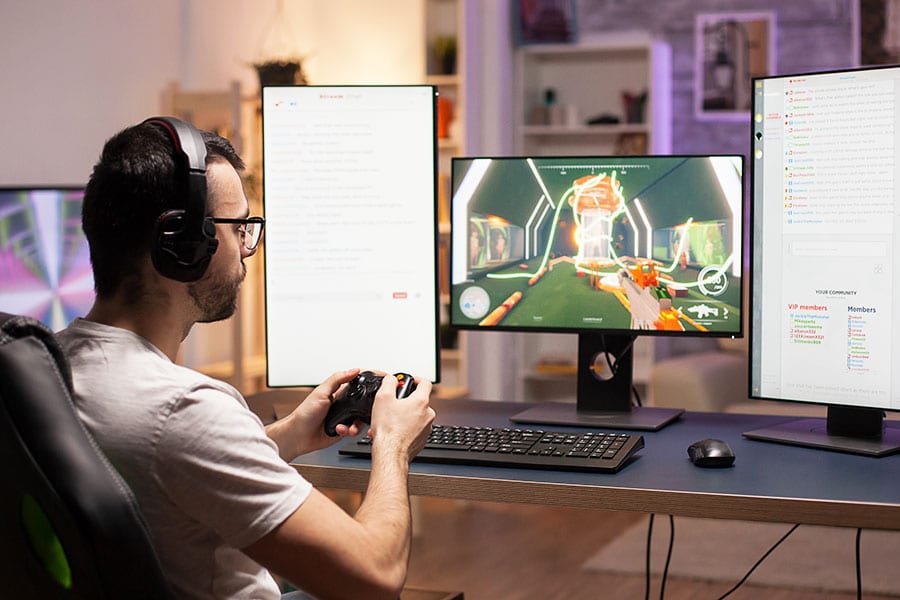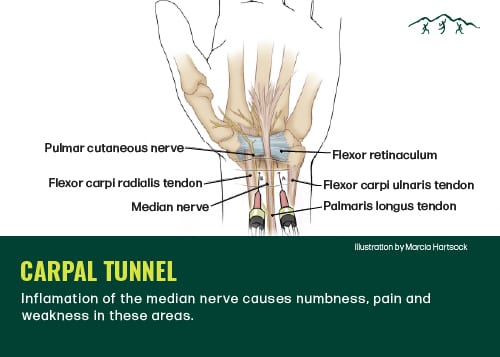Avid gamers can tell you that the world of esports isn’t always easy and pain-free. Learn the 3 most common video game injuries and how to treat, and more importantly, prevent, these injuries to keep your game hands strong.
Although we don’t talk about them as frequently, injuries in esports are fairly common. We spoke with certified hand therapist Doug Rich at our Red Mountain Clinic who has seen and treated the gamut of video game injuries.
Doug boasts an impressive resume with 25 years of experience as a physical therapist, 15 years as a certified hand therapist, and a certification in trigger point dry needling that makes him one of only a handful of hand therapists in the valley that can perform dry needling.
We asked Doug about the most common gaming injuries, causes, symptoms, prevention, and treatment.
What are the Most Common Video Game Injuries?
The most common video game injuries we see are gamer’s thumb, carpal tunnel syndrome, and tennis elbow. However, the world of video games is more expansive than just console games. Doug breaks common video game injuries into 4 main categories:
- Console video game injuries. These are the most common injuries that bring gamers into the clinic. Most common injuries include gamer’s thumb and tennis elbow.
- Computer video game injuries. These injuries are consistent with desk-job injuries, with carpal tunnel syndrome being the most common.
- Wii Sports & active video game injuries. It’s true; you can develop the same injuries as tennis, soccer, bowling, etc. by playing the e-sport equivalent. We encourage active game players to follow the same prevention techniques as athletes playing that sport. Make sure to warm up properly, keep good form (yes, really!), and keep up strength and mobility work. And remember to take a break since you won’t get as winded or play as long as if you were really playing the sport.
- Virtual reality video game injuries. Virtual reality has opened up a whole new world of video game experience where players are fully immersed in the game. While doing this, faces and eyes are covered, and players are unable to see what’s around them. There has since been a surge in falls and acute injuries in virtual reality players that we’ve seen in our clinics.
Since gamer’s thumb, carpal tunnel syndrome, and tennis elbow are the most common game-related injuries, we’ll dive a little deeper into those to teach you what you can do to relieve some of your pain without giving up your hobby.
Gamer’s Thumb or Wrist
The most common and widely known video game injury gamers experience is gamer’s thumb. Like runner’s knee, it’s one of those pesky overuse injuries that come with the territory when learning your body’s limits in a new activity.
What is Gamer’s Thumb or Wrist?
Tenosynovitis of the first compartment of the wrist, more commonly known as gamer’s thumb, gamer’s wrist, or de Quervain’s syndrome. This condition is characterized by inflammation of the tendons in the wrist and thumb, typically presenting as a sore thumb or wrist pain. This is caused by repetitive use, and in this case, repetitive video game play. It’s also especially common for new mothers due to the repetitive action of lifting their new baby.
Alternative Names for Gamer’s Thumb
You may hear this common injury referred to by many names. The technical diagnosis is tenosynovitis of the first compartment of the wrist. Yeah, it’s a mouthful! That’s why gamer’s thumb has lots of nicknames, including:
- de Quervain’s syndrome
- de Quervain’s tenosynovitis
- Gamer’s wrist
- de Quervain’s disease
- de Quervain’s tendonitis
What Causes Gamer’s Thumb or Wrist?
Specifically for video game use, the most common cause is the repetitive motion of console or keyboard play. Engaging in these repetitive motions for a prolonged period of time with little to no real breaks is the most common cause we see.
According to Mayo Clinic, there are a few risk factors and groups of people more prone to gamer’s thumb. Risk factors include:
- Age. Most commonly 30-50 years old.
- Sex. Women are more likely to suffer de Quervain’s syndrome. However, it is unclear whether that is a genetic predisposition or due to the repetitive motion of picking up a new baby being a primary cause. There is no evidence that suggests women are more likely than men to get this injury from video games.
- Pregnancy. Some evidence suggests a correlation between pregnancy and de Quervain’s syndrome.
Symptoms of Gamer’s Thumb or Wrist
If you’re big into esports, it’s pretty easy to tell when you’ve developed a gamer’s thumb. Look out for these 3 symptoms:
- Pain in the thumb, especially during/after gaming
- Wrist pain, especially during/after gaming
- Pain specifically when rotating thumb and wrist down away from your forearm
If you’ve been experiencing any of these symptoms, you can do this quick at-home test to see if you could be suffering from gamer’s thumb:
If you experience pain completing the test above, we recommend making an appointment to get checked out by a certified hand therapist*.
*Note: Did you know that in many states, Arizona included, you don’t need a referral to see a physical therapist? In a direct access state, you can skip the general and move right toward physical therapy treatment.
SCHEDULE A FREE PAIN ASSESSMENT WITH DOUG
Treatment & Recovery for Gamer’s Thumb or Wrist Pain
Good news! Gamers typically don’t require a lot of time off for gamers’ thumb. Only in severe cases where pain becomes unreasonable and you can no longer maintain your daily activities does Doug recommend a prolonged break from gaming.
Physical therapy has proven to be extremely successful in treating gamers’ thumb and other game-related injuries. Typically your treatment will begin with an assessment of the injury. Your therapist will work with you on some stretching and strengthening exercises. They may also include ice and electronic stim in your treatment plan.
Below, you’ll see some hand exercises for gamers, hand and thumb stretches, and more treatments we do with our patients suffering from gamer’s thumb.
Additionally, Doug mentioned that he has seen an up to 50% increase in recovery with patients by incorporating trigger point dry needling into their therapy. Dry needling uses tiny needling to quickly release muscle tension; Doug refers to it as “30 massages in 30 seconds”. Very few hand therapists are also certified in this technique. Doug is one of only a handful in the Phoenix area that is able to incorporate dry needling into his hand therapy treatments.
Carpal Tunnel Syndrome from Gaming
Carpal tunnel syndrome is most well known as a desk-job injury. There’s been a lot of research and literature about setting your desk up properly and using the right keyboard setup to avoid this injury. However, there’s less information out there regarding carpal tunnel from gaming. Carpal tunnel syndrome is one of the most prominent e-sport injuries, and it can affect all types of gamers.
What is Carpal Tunnel Syndrome?
The carpal tunnel is a narrow pathway that runs from your wrist to your hand. There is a nerve called the median nerve that runs through it. The median nerve can become compressed from overuse and/or a poor set-up, causing numbness, tingling, and weakness in your hand.
What Causes Carpal Tunnel Syndrome?
Carpal tunnel in gamers is caused by repetitive gripping with an extended wrist. This is common in both console and computer video games, as well as traditional daily computer use. According to Mayo Clinic, there are a few risk factors and groups of people more prone to carpal tunnel syndrome. Risk factors include:
- Sex. Women are more likely to suffer from carpal tunnel syndrome. This is likely due to the fact that the carpal tunnel passage is more narrow in women than men, making compression on the median nerve more likely.
- Anatomy. Although women are typically more likely to have a more narrow carpal tunnel, this can be a risk factor for both men and women. Additionally, acute injuries and arthritis can alter the carpal tunnel, making it more narrow and more likely to compress the median nerve.
- Medical conditions. Diabetes, rheumatoid arthritis, menopause, thyroid disorders, kidney failure, and lymphedema are known to be risk factors.
- Pregnancy / fluid retention. Fluid retention can cause pressure within your body that can irritate or initiate compression on your median nerve, causing or worsening carpal tunnel syndrome.
Symptoms of Carpal Tunnel Syndrome
If you believe you may be suffering from carpal tunnel syndrome from gaming or otherwise, there are a few tell-tale symptoms to look out for:
- Hand numbness, particularly in your thumb and first 2 fingers
- Thumb numbness while playing video games
- Tingling or pins-and-needles feeling in your hands, particularly in your thumb and first 2 fingers
- Hand weakness causing you to drop things or lose your grip
Treatment & Recovery for Carpal Tunnel Syndrome
We’ve found that in most cases, physical therapy can eliminate the need for invasive surgeries and excessive medications. There are a variety of hand and wrist exercises a person with carpal tunnel syndrome can do to attempt to relieve their symptoms.
Tennis Elbow from Gaming
Don’t let this name fool you; gamers suffer from tennis elbow fairly frequently, and not just as a result of too much time playing Wii Tennis. In fact, tennis elbow is a common injury resulting from any repetitive wrist and arm movement, as well as activities that engage your grip, like weightlifting, gymnastics, and you guessed it, esports.
What is Tennis Elbow?
Tennis elbow, technically referred to as lateral epicondylitis, is a type of tendonitis where the tendons that run from your elbow down through your forearm become inflamed, typically due to overuse.
What Causes Tennis Elbow?
Aside from traditional repetitive use, prolonged grip on a gaming console without proper posture, and particularly, without regulated breaks can cause these tendons to become inflamed, causing elbow pain. This is the most typical cause we see in esports enthusiasts. While we learned that there are several risk factors for other video-game-related injuries, tennis elbow doesn’t typically involve any specific risk factors beyond activities or careers that involve repetitive arm movements.
It typically comes down to repetitive gripping and bending the wrist up or down. This is exacerbated if the shoulders are not retracting (drawing back) and moving to help assist this movement. To decrease the stress on your elbow, avoid moving just your wrist; instead, retract your shoulders to help take some of the pressure off your elbow. According to Mayo Clinic, most cases are seen in adults ages 30-50.
Symptoms of Tennis Elbow
If you’ve been experiencing pain in your elbow and forearms due to prolonged video game use or any other repetitive motion, it’s possible you’re suffering from tennis elbow. Tennis elbow typically causes pain and weakness during your preferred activity as well as the following everyday tasks:
- Shaking hands
- Turning a doorknob
- Holding a coffee cup
Doug shows a quick assessment he does to determine if a patient is suffering from tennis elbow:
If you’re experiencing any of these symptoms, we recommend making an appointment with a certified physical therapist (for elbow issues, you don’t need to specifically go to a hand therapist) to assess your injury.
Treatment & Recovery for Tennis Elbow
When symptoms are acute, Doug recommends taking a short break from your gaming activities to allow the inflamed tissue to heal. Only in severe cases where pain becomes unreasonable and you can no longer maintain your daily activities does Doug recommend a prolonged break from gaming. Physical therapy has proven to be extremely successful in treating tennis elbow from gaming. Typically your treatment will begin with an assessment of the injury. Your therapist will work with you first to improve your posture and stretch out the front of your chest, allowing you to play with less pressure coming down your arms. Your therapist will also work with you to stretch the area around the tendons that come down through the elbow and become inflamed with tennis elbow. Additionally, they will provide eccentric exercises to strengthen the arm and thicken those tendons to avoid repeat injury. They may also include ice and electronic stim in your treatment plan. Like gamer’s thumb, Doug mentioned that he has seen big improvements in patients by incorporating trigger point dry needling into their tennis elbow therapy. We recommend looking for a physical therapist certified in dry needling when you’re assessing your treatment options.
How to Prevent Gamer’s Thumb & Other Video Game Injuries
The two best ways to prevent video game injuries are built-in breaks and creating a proper set-up that allows you to play with good form and posture.
Take a Break to Prevent Video Game Injuries
The best way to prevent gamers’ thumb and other video-game-related injuries is to take a break every hour. Get up and walk around for just a few minutes. It helps to set a timer or alert on your phone to make sure you don’t get distracted and remain stationary for too long. Many gamers will take ~30 seconds, shake their hands out, and return to playing. Doug warns this is not enough. The prolonged sitting position causes stress on your tendons running all the way down to your hands. The only way to properly care for your body and prevent these injuries is to stand up, put the console down, and walk around for a couple of minutes before returning to play. These few minutes can prevent painful injuries down the road. It’s always better to sacrifice a few minutes upfront so that you don’t have to sacrifice a few weeks off later on due to an injury.
Set Yourself up for Success
Additionally, maintaining a good setup with your computer or gaming system is very important. If you’re using a keyboard, invest in one that is ideal for long periods of use. Also, make sure your wrists are elevated above your fingers. Consider a standing set-up with your gaming console, and make sure you’re using controls designed for long periods of use. Have you been experiencing pain playing during or after gaming? Schedule a free 15-minute injury assessment to determine if you might be suffering from gamer’s thumb, carpal tunnel syndrome, or tennis elbow.







